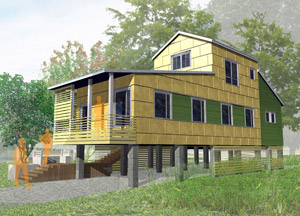Working with Water
Designing for resilience
In the last decade, the term resilience has come to embody a multifaceted approach to promote the ability of the natural and built environment to sustain itself through extreme events. Timothy Beatley, professor of sustainable communities at the University of Virginia, points out that most current planning models consider only 20- to 30-year cycles and are rarely coordinated at the regional or national levels. Cities like New Orleans and New York need 100- or even 200-year plans that have a broader scope and take into account ecosystems and their flood-resistant qualities, he says. Beatley also cautions that certain regions will need to consider shifting land-use patterns. "We're going to have to think about strategic retreat in some areas."
For resilience at the building scale, Beatley points to the idea of "passive survivability": the ability of buildings to maintain livable conditions after the loss of essential services. Any strategy that enhances the self-sufficiency of a building can extend its viability as shelter in the aftermath of debilitating storms. Off-grid energy systems such as photovoltaics, solar water heating, and on-site water collection can keep basic services going. Reducing demand by designing in a high-efficiency envelope and using passive heating and cooling techniques can also help.
The flood-resistant building
Of course, passive survivability assumes that the structure remains intact after an event like a tropical storm or tsunami. The National Institute of Building Sciences publishes a Whole Building Design Guide on flood-resistant buildings. The guide describes strategies to allow a building to survive waterborne disasters with minimal damage.
The Federal Emergency Management Agency (FEMA) publishes maps that designate Special Flood Hazard Areas delineated by a Base Flood Elevation (BFE). This benchmark is often set at the level of a 100-year flood - a flood that has a 1 percent chance of being equaled or exceeded in a given year. Local codes typically designate a Design Flood Elevation (DFE) based on the FEMA maps. Coastal zones are often more restricted since they are potentially subject to more severe conditions, such as wave action. The recent images of houses floating down the swollen rivers of Brisbane, Australia, are a reminder that the safest option is keeping new structures away from vulnerable zones.
 |
Waggonner & Ball's house for the Lower Ninth Ward in New Orleans plays on the local vernacular and has a raised first floor. Image: Courtesy Waggonner & Ball |
If there's no choice but to build in a flood-prone area, a level of safety can be achieved by lifting the structure's habitable parts above the DFE. In many cases, this requires elements such as piers that can withstand hydrostatic and debris loads. Brad Pitt's Make It Right Foundation commissioned Waggonner & Ball to design such a flood-resistant house for New Orleans. The prototype plays on the vernacular of the shotgun house but raises the first floor 8 feet to protect it from flooding and provide a place to park cars.
In inland zones where the structure won't be subject to wave action, the area of the building below the DFE can
often be constructed to withstand flooding with only cosmetic damage. This strategy, known as wet flood-proofing, was explored in a winning entry in the U.K.'s Norwich Union Flood Design competition. London-based Nissen Adams developed a housing model that uses materials such as masonry that can withstand water on the lower level.
The plan is organized so that nonessential functions like bedrooms are placed on the lower level, allowing occupants to relocate to the upper floor in a flood. Dry flood-proofing is a more involved strategy of essentially making the building watertight and able to withstand extreme hydrostatic pressure. In both cases, designers should consider the buoyancy of the structure and ensure that the foundation is protected from the erosive effect of floodwaters. There is also a range of mechanical flood barriers for buildings that are either deployed automatically or manually.









